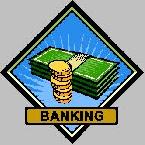
 |
|
| Financial Terms | |
| Net advantage to merging |
|
Information about financial, finance, business, accounting, payroll, inventory, investment, money, inventory control, stock trading, financial advisor, tax advisor, credit.
Main Page: stock trading, credit, accounting, business, tax advisor, payroll, inventory control, finance, |
Definition of Net advantage to merging
Net advantage to mergingThe difference in total post- and pre-merger market value minus the cost of the merger.
Related Terms:NPV (net present value of cash flows)Same as PV, but usually includes a subtraction for an initial cash outlay. Emerging marketsThe financial markets of developing economies. European Monetary System (EMS)An exchange arrangement formed in 1979 that involves the currencies Exposure nettingOffsetting exposures in one currency with exposures in the same or another currency, Firm's net value of debtTotal firm value minus total firm debt. International Monetary FundAn organization founded in 1944 to oversee exchange arrangements of International Monetary Market (IMM)A division of the CME established in 1972 for trading financial  Monetary goldGold held by governmental authorities as a financial asset. Monetary policyActions taken by the Board of Governors of the Federal Reserve System to influence the Monetary / non-monetary methodUnder this translation method, monetary items (e.g. cash, accounts Net adjusted present valueThe adjusted present value minus the initial cost of an investment. Net advantage of refundingThe net present value of the savings from a refunding. Net advantage to leasingThe net present value of entering into a lease financing arrangement rather than Net asset value (NAV)The value of a fund's investments. For a mutual fund, the net asset value per share Net assetsThe difference between total assets on the one hand and current liabilities and noncapitalized longterm Net benefit to leverage factorA linear approximation of a factor, T*, that enables one to operationalize the  Net book valueThe current book value of an asset or liability; that is, its original book value net of any Net cash balanceBeginning cash balance plus cash receipts minus cash disbursements. Net changeThis is the difference between a day's last trade and the previous day's last trade. Net errors and omissionsIn balance of payments accounting, net errors and omissions record the statistical Net financing costAlso called the cost of carry or, simply, carry, the difference between the cost of financing Net floatSum of disbursement float and collection float. Net incomeThe company's total earnings, reflecting revenues adjusted for costs of doing business, Net investmentGross, or total, investment minus depreciation. Net leaseA lease arrangement under which the lessee is responsible for all property taxes, maintenance Net operating lossesLosses that a firm can take advantage of to reduce taxes. Net operating marginThe ratio of net operating income to net sales.  Net periodThe period of time between the end of the discount period and the date payment is due. Net present value (NPV)The present value of the expected future cash flows minus the cost. Net present value of growth opportunitiesA model valuing a firm in which net present value of new Net present value of future investmentsThe present value of the total sum of NPVs expected to result from Net present value ruleAn investment is worth making if it has a positive NPV. Projects with negative NPVs Net profit marginnet income divided by sales; the amount of each sales dollar left over after all expenses Net salvage valueThe after-tax net cash flow for terminating the project. Net working capitalCurrent assets minus current liabilities. Often simply referred to as working capital. Net worthCommon stockholders' equity which consists of common stock, surplus, and retained earnings. NettingReducing transfers of funds between subsidiaries or separate companies to a net amount. Netting outTo get or bring in as a net; to clear as profit. Payments nettingReducing fund transfers between affiliates to only a netted amount. netting can be done on Safety-net returnThe minimum available return that will trigger an immunization strategy in a contingent SIMEX (Singapore International Monetary Exchange)A leading futures and options exchange in Singapore. NET INCOMEThe profit a company makes after cost of goods sold, expenses, and taxes are subtracted from net sales. NET SALES (revenue)The amount sold after customers’ returns, sales discounts, and other allowances are taken away from RATIO OF NET INCOME TO NET SALESA ratio that shows how much net income (profit) a company made on each dollar of net sales. Here’s the formula: RATIO OF NET SALES TO NET INCOMEA ratio that shows how much a company had to collect in net sales to make a dollar of profit. Figure it this way: Net present value (NPV)A discounted cash flow technique used for investment appraisal that calculates the present value of future cash flows and deducts the initial capital investment. Net profitSee operating profit. Net incomeThe last line of the Income Statement; it represents the amount that the company earned during a specified period. net income (also called the bottom line, earnings, net earnings, and netoperating earnings) net present value (NPV)Equals the present value (PV) of a capital investment net worthGenerally refers to the book value of owners’ equity as reported Net Present Value (NPV)The present value of all future cash inflows minus the present value approximated net realizable value at split-off allocationa method of allocating joint cost to joint products using a Internet business modela model that involves intraneta mechanism for sharing information and delivering data from corporate databases to the local-area network (LAN) desktops net cost of normal spoilagethe cost of spoiled work less the estimated disposal value of that work net present value (NPV)the difference between the present values of all cash inflows and outflows for an investment project net present value methoda process that uses the discounted net realizable value approacha method of accounting for by-products or scrap that requires that the net realizable value of these products be treated as a reduction in the cost of the primary products; primary product cost may be reduced by decreasing either net realizable value at split-off allocationa method of allocating joint cost to joint products that uses, as the proration base, sales value at split-off minus all costs necessary network organizationa flexible organization structure that Net incomeThe excess of revenues over expenses, including the impact of income taxes. Net present valueA discounted cash flow methodology that uses a required rate of Net realizeable valueThe expected revenue to be gained from the sale of an item or Net salesTotal revenue, less the cost of sales returns, allowances, and discounts. net floatDifference between payment float and availability float. net present value (NPV)Present value of cash flows minus initial investment. net working capitalCurrent assets minus current liabilities. net worthBook value of common stockholders’ equity plus preferred stock. Absolute AdvantageThe ability to produce a good or service with fewer resources than competitors. See also comparative advantage. Comparative AdvantageA country has a comparative advantage over another country in the production of good A if to produce a unit of A it forgoes more of the production of good B than would the other country when it produces a unit of good A. Its efficiency in the production of good A relative to its efficiency in the production of good B is greater than is the case for the other country. See also absolute advantage. International Monetary Fund (IMF)Organization originally established to manage the postwar fixed exchange rate system. MonetarismSchool of economic thought stressing the importance of the money supply in the economy. Adherents believe that the economy is inherently stable, so that policy is best undertaken through adoption of a policy rule. Monetarist RuleProposal that the money supply be increased at a steady rate equal approximately to the real rate of growth of the economy. Contrast with discretionary policy. Monetary AggregateAny measure of the economy's money supply. Monetary BaseSee money base. Monetary PolicyActions taken by the central bank to change the supply of money and the interest rate and thereby affect economic activity. Monetizing the DebtSee printing money. Net Domestic ProductGDP minus depreciation. Net National ProductGNP minus depreciation. Net ExportsExports minus imports. Net InvestmentInvestment spending minus depreciation. Net PayThe amount of an employee’s wages payable after all tax and other deductions have been removed. Emerging Issues Task Force (EITF)A special committee of the Financial Accounting Standards Board established to reach consensus of how to account for new and unusual financial transactions that have the potential for creating differing financial reporting practices. Emerging Issues Task Force (EITF)A separate committee within the Financial Accounting Standards Board composed of 13 members representing CPA firms and preparers of financial statements Net Cash after OperationsCash flow available for debt service—the payment of interest and principal on loans. Generally calculated as cash provided by operating activities before interest Net inventoryThe current inventory balance, less allocated or reserved items. Order penetration pointThe point in the production process when a product is Competitive AdvantageThe strategies, skills, knowledge, resources or competencies that differentiate a business from its competitors. Net Present Value (NPV) MethodA method of ranking investment proposals. NPV is equal to the present value of the future returns, discounted at the marginal cost of capital, minus the present value of the cost of the investment. Net Realizable ValueSelling price of an asset less expenses of bringing the asset into a saleable state and expenses of the sale. Net WorthThe difference between the total assets and total liabilities of a company. Note: The value of the preferred shares is deducted from the net worth because the preferred's are usually redeemed before any value is paid to the common shareholders. net asset valueThe value of all the holdings of a mutual fund, less the fund's liabilities. Related to : financial, finance, business, accounting, payroll, inventory, investment, money, inventory control, stock trading, financial advisor, tax advisor, credit. |